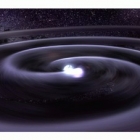"Follow the Chirp: Searching and Characterizing Electromagnetic Counterparts of Gravitational Wave Sources.”
The mergers of binary
compact objects (black holes, neutron stars, white dwarfs) are amongst some of
the most violent events in the Universe. The physics driving these events in
strongly curved spacetimes are complex, rich and still remain elusive. These
cosmic laboratories present us now with both a challenge and an opportunity.
The challenge is to explain the physics at play in strong-field gravity in
Universe. The opportunity is to detect the accompanying electromagnetic and
gravitational radiation for the first time with a suite of time-domain
telescopes and newly upgraded gravitational wave (GW) detectors. In this
pivotal era of strong-field gravity astronomy, the most compelling
astrophysical sources are neutron star binary mergers, which should emit both
in electromagnetic (EM) and GWs. I will first review the most recent advances in
this blossoming field of EM + GW astronomy, which combines three active
disciplines: time-domain astronomy, computational astrophysics and general
relativity. I will discuss the promises of this new convergence by illustrating
the wealth of astrophysical information that a combined EM+GW measurement would
immediately bring. I will then outline the main challenges that lie ahead for
this new field in pinpointing the sky location of neutron star mergers using GW
detectors and optical and radio wide-field synoptic telescopes.

